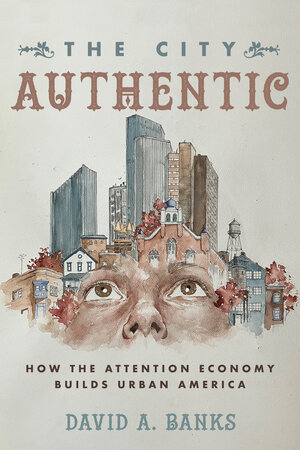By David A. Banks, author of The City Authentic: How the Attention Economy Builds Urban America
We’ve all seen headlines featuring interesting commentary on U.S. cities’ images or brands. In the lead up to my new book, The City Authentic: How the Attention Economy Builds Urban America,I’ve been collecting these relevant tidbits and quotes. One of my recent favorites is NYC mayor Eric Adams proclaiming that “Kansas doesn’t have a brand.” Another is a joke about how over-priced taco places have goofy names and bad decorations. And there’s the fact that my small upstate city of Troy, New York was featured in not one but two whole Hallmark Channel Christmas movies last year. All of these are artifacts of the city authentic, my phrase for the set of polices, practices, and ideas that use our modern desires for meaning and belonging to drive economic development. Cities use their history, geography, and unique culture to set themselves apart while encouraging residents and visitors to do the same, especially on social media.
Adams may be a bit more bombastic (and rude to Kansas), but he’s saying what many mayors, economic development officials, and social media mangers have been talking about for years: if cities want to grow and thrive in the attention economy, they have to act like the reality TV stars and Instagram influencers that dominate it. In other words, cities must have a brand.
Larger cities like New York City have clearly established name-brand appeal. But increasingly, smaller cities and towns are positioning themselves as the trendy thrift store find to bigger cities’ mainstream appeal. Anyone can dream of a life in Chicago or Los Angeles, but you — dear reader of an Instagram ad by the Capital District’s Center for Economic Growth— are a savvy consumer of urbanism. You know that you can get the same walkable streets, hip bars, and trendy lofts for a fraction of the price if you move to Albany, New York. In this way, entire regions can plug into circuits of capital that were once off limits. Suddenly, developers who wouldn’t have looked twice at their empty lots are running the numbers and finding that, with a bit of embellishment, Rust Belt cities can bring in the returns.
If cities want to grow and thrive in the attention economy, they have to act like the reality TV stars and Instagram influencers that dominate it. In other words, cities must have a brand.
David A. Banks
By tying cities’ aspirations for both economic growth and media acclaim to a political economy of infinite capitalist expansion, I build on another great book in this area, Urban Fortunes by John R. Logan and Harvey Molotch. Logan and Molotch argue that although cities’ elites disagree about many things, they often agree that cities should be constantly building, advertising, and reinvesting capital to realize profits at the expense of livability and stability. While this is still true, the growth machine has been significantly upgraded in the 35 years since Urban Fortunes was first published. Markets and their speculators have more tools than ever to collude on rent prices. The structural speculators that move markets to suit their holdings can reach further geographically, see across a longer time horizon, and advertise their properties with more enticing language.
At the same time, we’re more susceptible today to the siren song of authenticity. In a fast-paced modern world that serves alienation and convenience in equal measure, the predictable uniqueness of a just-a-little-bit-quirky city feels comforting. By referencing the industries, companies, and people of the nineteenth century in twenty-first century marketing copy, any average bar or apartment complex can feel rooted in history. Often these connections don’t run any deeper than an athlete’s shoe brand endorsement or an influencer’s favorite lip gloss. Even if on some level you know it’s just marketing, it feels nice to believe that you’re somewhere that was fully conceived before there was a billion-dollar industry devoted to figuring out exactly what you want to buy.
The city authentic is ascendant but it isn’t destiny. A union-driven democratized economy would not only bring equity to the work place — it could bring more meaning to our lives. Once we stop looking for Instagram-ready digs and start building the humble communities that sustain fulfilling lives, we can throw a wrench in the growth machine for good.

